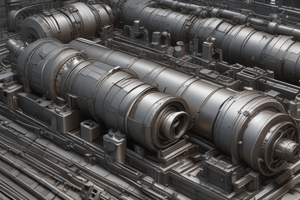Podcast
Questions and Answers
What is a key advantage of permanent-mold casting over expendable mold processes?
What is a key advantage of permanent-mold casting over expendable mold processes?
What materials are commonly used to construct permanent molds?
What materials are commonly used to construct permanent molds?
Which of the following metals is NOT listed as commonly cast in permanent molds?
Which of the following metals is NOT listed as commonly cast in permanent molds?
What type of cores can be used in permanent molds to form interior surfaces in the casting?
What type of cores can be used in permanent molds to form interior surfaces in the casting?
Signup and view all the answers
What is the purpose of preheating and coating the mold in the permanent-mold casting process?
What is the purpose of preheating and coating the mold in the permanent-mold casting process?
Signup and view all the answers
What term is used when sand cores are used in a permanent mold?
What term is used when sand cores are used in a permanent mold?
Signup and view all the answers
What is the purpose of preheating the mold in the permanent-mold casting process?
What is the purpose of preheating the mold in the permanent-mold casting process?
Signup and view all the answers
Why must the permanent mold be opened soon after the metal solidifies?
Why must the permanent mold be opened soon after the metal solidifies?
Signup and view all the answers
What is a key advantage of permanent-mold casting in terms of surface finish and dimensional control?
What is a key advantage of permanent-mold casting in terms of surface finish and dimensional control?
Signup and view all the answers
Why is die casting limited to metals of lower melting points?
Why is die casting limited to metals of lower melting points?
Signup and view all the answers
Which type of casting process is best suited for high-volume production due to mold cost considerations?
Which type of casting process is best suited for high-volume production due to mold cost considerations?
Signup and view all the answers
What are typical parts that are produced using permanent-mold casting?
What are typical parts that are produced using permanent-mold casting?
Signup and view all the answers
What is the primary distinguishing feature of the die casting process compared to other permanent mold casting processes?
What is the primary distinguishing feature of the die casting process compared to other permanent mold casting processes?
Signup and view all the answers
What is the purpose of the piston in a hot-chamber die-casting machine?
What is the purpose of the piston in a hot-chamber die-casting machine?
Signup and view all the answers
What is the main difference between hot-chamber and cold-chamber die-casting machines?
What is the main difference between hot-chamber and cold-chamber die-casting machines?
Signup and view all the answers
What is the typical sequence of steps in a die-casting cycle?
What is the typical sequence of steps in a die-casting cycle?
Signup and view all the answers
What is the purpose of maintaining pressure during solidification in the die-casting process?
What is the purpose of maintaining pressure during solidification in the die-casting process?
Signup and view all the answers
What is the function of the die-casting machine in the die-casting process?
What is the function of the die-casting machine in the die-casting process?
Signup and view all the answers
In cold-chamber die-casting machines, how is the molten metal initially introduced into the die cavity?
In cold-chamber die-casting machines, how is the molten metal initially introduced into the die cavity?
Signup and view all the answers
Which of the following is NOT an advantage of die casting?
Which of the following is NOT an advantage of die casting?
Signup and view all the answers
What is the primary purpose of the ram in the die casting process?
What is the primary purpose of the ram in the die casting process?
Signup and view all the answers
Which of the following statements about centrifugal casting is true?
Which of the following statements about centrifugal casting is true?
Signup and view all the answers
What is the typical grain size of castings produced by die casting?
What is the typical grain size of castings produced by die casting?
Signup and view all the answers
Which of the following casting methods is NOT mentioned in the text as part of the centrifugal casting group?
Which of the following casting methods is NOT mentioned in the text as part of the centrifugal casting group?
Signup and view all the answers
What is the primary cause of mold crack according to the passage?
What is the primary cause of mold crack according to the passage?
Signup and view all the answers
What can happen when mold crack occurs?
What can happen when mold crack occurs?
Signup and view all the answers
Which of the following is a method used to detect internal defects in a casting?
Which of the following is a method used to detect internal defects in a casting?
Signup and view all the answers
What is the purpose of mechanical testing on the cast metal?
What is the purpose of mechanical testing on the cast metal?
Signup and view all the answers
What can be done if defects are discovered in a casting but are not too serious?
What can be done if defects are discovered in a casting but are not too serious?
Signup and view all the answers





